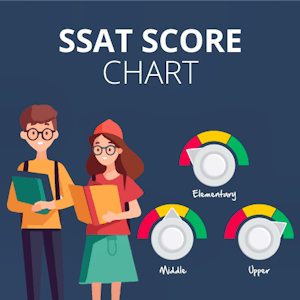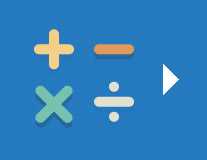SSAT Score Chart – Range, Results, Chart, Percentiles & More
Updated November 29, 2023

- What Is the SSAT Test?
- The SSAT Score Report
empty
empty
- SSAT Score Chart
- What Is a Good SSAT Score?
empty
empty
empty
empty
empty
- When Are SSAT Scores Released?
empty
empty
empty
- What to Know About the SSAT Scores
empty
empty
empty
- Frequently Asked Questions
- Final Thoughts

The main three sections for the Upper and Middle level tests have a maximum score of 800. They have a total scaled score that ranges between 1,500 to 2,400.
Navigating the SSAT involves understanding its scoring system.
In this guide, you can explore the SSAT Score Chart and understand score ranges and percentile ranking and how they matter in private school admissions.
It's a comprehensive resource for decoding SSAT scores and making informed decisions about your child’s education.
What Is the SSAT Test?
The SSAT stands for the Secondary School Admission Test. The SSAT was first administered in 1957.
It is a standardized test designed for students seeking admission to private middle and high schools.
The primary purpose of the SSAT is to assess the skills and knowledge of students applying to independent or private schools.
It aims to provide an accurate measure of a student's academic abilities and readiness for a challenging curriculum.
Students typically take the SSAT when applying for admission to private middle or high schools.
Schools use SSAT scores as one of the factors in their admission decisions.
The test helps schools evaluate a student's verbal, math and reading skills, providing a standardized metric for comparing applicants from diverse educational backgrounds.
Taking the SSAT is often a requirement for admission to these schools and can play a crucial role in the application process.
The SSAT Score Report
The SSAT score report provides a comprehensive overview of a student's performance on the test.
It's important to note that there are three different levels of the SSAT:
- Elementary
- Middle
- Upper
These levels cater to students at various educational stages.
Here's what you can find in the SSAT score report:
Total Scores
Total Scaled Score
This is the sum of the scaled scores from the Quantitative, Reading and Verbal sections.
The range for the total scaled score varies depending on the level (Elementary, Middle or Upper).
Total Percentile
Indicates the percentage of students whose scores fall below the student's score
A higher percentile suggests a stronger performance relative to other test-takers.
Section Scores
- Quantitative – Reflects the student's mathematical abilities. The scaled score is provided, giving a measure of proficiency in quantitative reasoning.
- Reading – Assesses the student's reading comprehension skills. The scaled score indicates performance in understanding and interpreting written passages.
- Verbal – Evaluates the student's vocabulary and verbal reasoning skills. The scaled score measures proficiency in language-related tasks.
Understanding the score report and SSAT score range is crucial for both students and schools during the admission process.
It provides a detailed breakdown of the student's strengths and areas that may need improvement.
The Total Score and Section Scores offer insights into academic abilities, helping schools make informed decisions about admissions.
SSAT Score Chart
The SSAT scoring system varies across its three levels – Elementary, Middle and Upper.
Understanding the SSAT score range is pivotal for interpreting performance and making informed decisions in the admissions process.
| Level | Scaled score range per section | Total scaled score range |
|---|---|---|
| Elementary | 300 to 600 | 900 to 1,800 |
| Middle | 440 to 710 | 1,320 to 2,130 |
| Upper | 500 to 800 | 1,500 to 2,400 |
SSAT score percentiles offer a relative measure of a student's performance compared to their peers who took the same test.
For example, if a student's SSAT percentile is 70, it means they performed as well as or better than 70% of the test-takers.
The percentile system is crucial in the context of school admissions. Elementary, Middle and Upper level SSAT scores percentile chart samples are available on the official SSAT website.
A higher percentile indicates a stronger performance relative to other applicants.
Schools often consider both the raw scores and percentiles when evaluating candidates.
What Is a Good SSAT Score?
Deciphering what constitutes a "good" SSAT score involves considering various factors.
It's important to note that what's considered good can vary based on individual circumstances and school expectations.
In the SSAT score report, you'll often find average scores for each section and the total score.
These averages provide a benchmark for how students typically perform on the test.
For example, the average SSAT score for 8th grader students would vary depending on a range of factors such as a particular section or the total score.
However, it's crucial to remember that a good score is relative and depends on the student's goals and the admission requirements of the specific schools.
Here are some key points to consider:
Averages in the Score Report
The score report typically includes average SSAT scores for the tested population.
Comparing a student's scores to these averages can provide a sense of how they measure up.
Individual Goals
What might be a good score for one student may not be the same for another.
Consider the student's academic strengths, weaknesses and personal goals.
School Expectations
Different schools may have varying expectations so there’s no average SSAT score.
Some sections may be prioritized over others when considering the SSAT scores for private schools.
This means it's beneficial to research the admission criteria of the specific schools of interest.

If you want 12-month access to all the practice resources for this test, our partner TestPrep-Online.com offers a Family Membership.
Family Membership gives you access to all the TestPrep-Online resources for the next 12 months. You will also get two separate accounts, which can be very helpful if you have two children preparing for their tests.
Consult With Teachers or Advisors
Teachers and school advisors can provide valuable insights into what might be considered a good score.
This will be based on the student's academic background and the expectations of prospective schools.
Consider the Percentile
The percentile rank on the score report indicates how a student's performance compares to others.
A higher percentile suggests a stronger performance relative to peers.
When Are SSAT Scores Released?
The timing of SSAT score releases can vary depending on the format of the test. Here's a breakdown:
Paper SSAT
Scores for the traditional paper-based SSAT are typically released within two weeks of the test date.
This allows for the scoring process and result compilation before dissemination.
SSAT at Home
For the SSAT taken at home, scores are typically released on the following Wednesday of the test date.
It's a relatively quick turnaround, providing students with prompt access to their results.
Note that some Tuesday test dates might have scores released eight days after testing, on the second Wednesday from the test.
Prometric Test
If the SSAT is taken at a Prometric test center, scores are usually released on the Wednesday following the weekly scoring period.
This timeline allows for the necessary processing and verification of scores.
What to Know About the SSAT Scores
There are a few important things to know about the scores, scoring system and the test in general.
Penalty for Wrong Answers (Middle and Upper Levels)
On the Middle and Upper levels of the SSAT, there is a penalty for incorrect answers.
The scoring system deducts a quarter of a point for each wrong answer.
This means that guessing carries a risk and strategic decision-making is important.
However, not answering a question does not result in a penalty.
It's crucial for test-takers to weigh the risks and benefits of guessing on these sections.
Retaking the Test
If possible, retaking the SSAT can be beneficial.
The test offers an opportunity for improvement and many students find that their scores increase with a second attempt.
Becoming familiar with the format, understanding the types of questions asked and gaining experience with test conditions can contribute to better performance in a retake.
Practice Tests and Score Enhancement
Practicing with SSAT sample tests is a valuable strategy for score enhancement.
Online practice tests can help students become comfortable with the test format, identify areas of strength and weakness and refine their test-taking strategies.
Regular practice allows for targeted study, focusing on specific content areas that may need improvement.
Frequently Asked Questions
A good SSAT score is relative and depends on various factors.
These include the level of the test (Elementary, Middle or Upper), the specific schools you're applying to and your individual goals.
Generally, a good score is one that meets or exceeds the admission requirements of your target schools.
A score of 2,400 is the highest possible combined scale score on the SSAT. The highest SSAT score achievable varies depending on the level of the test: 1,800 for Elementary, 2,130 for Middle and a SSAT max score of 2,400 for Upper. Each section and the total score have specific scaled score ranges.
The SSAT is not tied to a specific grade level. There are three levels of the test: Elementary (for students in grades three to four), Middle (for students in grades five to seven) and Upper (for students in grades eight to 11).
What's considered a good score for an 8th grader depends on various factors. A good SSAT max score would typically meet or exceed the admission requirements of the private schools the student is interested in attending.
The difficulty of SSAT sections can vary for different individuals. Some may find the Quantitative section challenging due to its emphasis on mathematical reasoning, while others may find the Verbal section more demanding because of vocabulary and verbal reasoning questions. It's subjective and varies from person to person.
A 70th percentile on the SSAT means that the student performed as well as or better than 70% of the students who took the test. It indicates a relatively strong performance.
The lowest possible score on the SSAT depends on the level. For example, the lowest total scaled score on the Upper level is 500, while on the Middle level it's 440. It's important to note that scores can go below these figures if a student leaves questions unanswered or answers questions incorrectly with the penalty for guessing (Middle and Upper levels).
Final Thoughts
Navigating the SSAT journey involves understanding its nuances and individualized nature.
A good SSAT score hinges on the level of the test, personal goals and the admission criteria of target schools.
Regular practice, using sample tests, can enhance familiarity and boost confidence.
Ultimately, success in the SSAT involves preparation, strategy and individual aspirations.
It’s important to approach the SSAT as an opportunity to showcase academic strengths to secure a pathway to a desired educational future.














